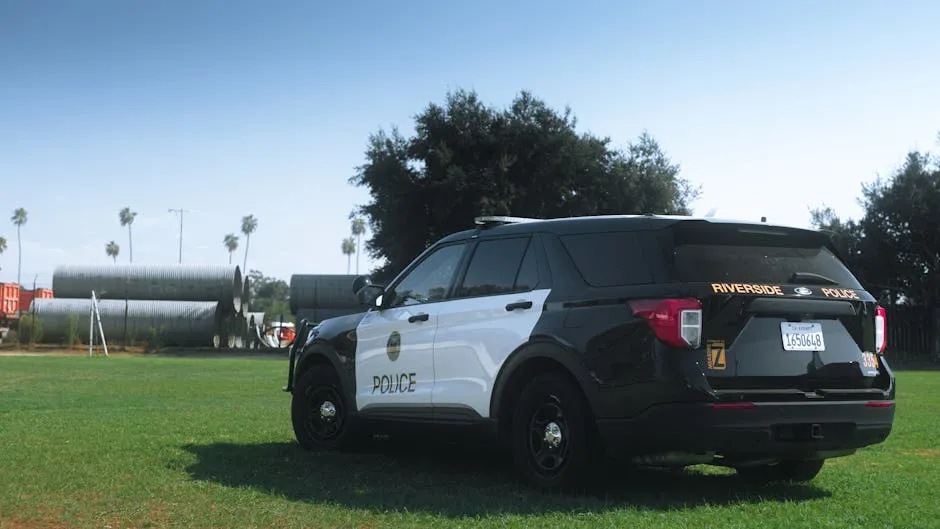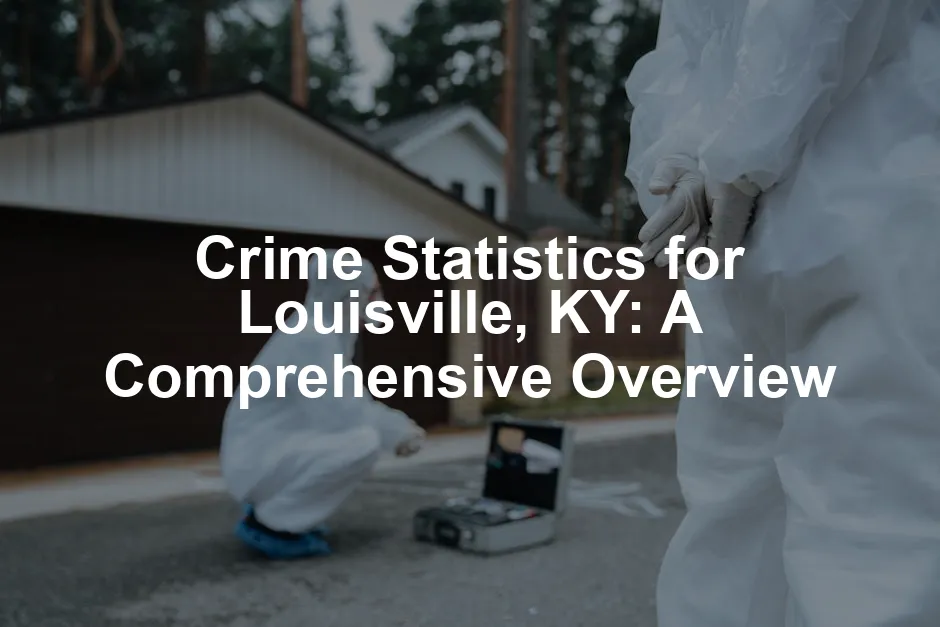Introduction
Crime statistics. A topic that stirs up a mix of emotions, especially for residents of Louisville, KY. Understanding these statistics is vital. Why? Because they provide insight into safety, community well-being, and even influence potential movers’ choices. Whether you’re a homeowner, an apartment seeker, or a policymaker, knowing the crime landscape can shape your decisions.
Louisville has long been known for its vibrant culture, delicious cuisine, and the Kentucky Derby. However, lurking behind its charm is a complex crime narrative that calls for attention. Recent years have seen fluctuations in crime rates, prompting residents and officials to take a closer look.
This article aims to furnish you with a thorough analysis of crime statistics in Louisville. We will uncover trends, compare local data against state and national averages, and provide insights into the city’s safety dynamics. Buckle up, because the numbers are about to get real!

Current Crime Overview
Understanding Crime Rates in Louisville
Let’s break down some key terms first.
- Violent Crime: These are offenses that involve force or threat. Think murder, robbery, and aggravated assault.
- Property Crime: This category covers theft-related offenses, including burglary and motor vehicle theft.
- Total Crime Rate: This measures all reported crimes in a specific area, expressed per 1,000 residents.
In Louisville, the overall crime rate stands at a staggering 37 per 1,000 residents. Yes, you read that right. That’s quite a bit higher than many other cities in the U.S.
To help combat the risks associated with crime, investing in a reliable Home Security Camera System can make a world of difference. Not only do these cameras provide peace of mind, but they also deter potential intruders, keeping your home safe and sound.

Statistics Snapshot
Now, let’s dive into some key statistics that will make your eyes widen and your heart race:
- Violent Crime Rate: 7.51 per 1,000 residents. This means that for every 133 people, one might fall victim to a violent crime. Yikes!
- Property Crime Rate: 29.17 per 1,000 residents. This gives you a 1 in 34 chance of having your belongings snatched away.
These figures paint a stark picture of the safety landscape in Louisville. Residents need to stay alert and informed, as understanding these numbers can lead to better safety practices in daily life.
For added personal security, consider carrying a Personal Safety Alarm. These handy devices can emit a loud sound to alert others in case of emergency, providing extra reassurance when you’re out and about.
The statistics also serve as a reminder for policymakers. They need to prioritize community safety initiatives and allocate resources effectively. In a city with such vibrant culture, a safe environment is crucial for its growth and appeal.
Stay tuned as we peel back more layers of Louisville’s crime story in the sections that follow!

Breakdown of Crime Types
Violent Crimes
In Louisville, violent crimes include categories like rape, murder, robbery, and aggravated assault. The statistics speak volumes. In recent years, Louisville reported approximately 4,719 violent incidents, resulting in a rate of 7.51 per 1,000 residents. This statistic suggests that for every 133 people you meet in Louisville, one could be a victim of violent crime.
When we look deeper into these numbers, a concerning trend emerges. For instance, Louisville’s violent crime rate is significantly higher than the Kentucky average of 2.14 per 1,000 residents and the national median of 4 per 1,000 residents. This puts Louisville in the spotlight, but not the kind of spotlight we want.
Examining specific categories, murder rates have shown fluctuations. The data indicates that the homicide rate has climbed, with 64 homicides reported in 2024 alone. Robberies and aggravated assaults also contribute heavily to the alarming statistics. The city faces challenges, with certain neighborhoods experiencing particularly high rates of violent crime, leading to increased community concerns and calls for action.

Violent Crime Trends
The trends are not comforting. Violent crime rates have seen an upward trajectory in recent years, raising alarms among residents and local officials. For example, comparing the current year to previous ones shows a 2% increase in shootings. This persistent rise has prompted discussions around community safety and policing strategies.
When comparing Louisville’s rate to Kentucky and national averages, the disparity becomes even clearer. While Kentucky has a much lower overall violent crime rate, Louisville’s figures paint a stark contrast. Such a situation not only affects the community’s perception of safety but also poses challenges for law enforcement and policymakers.
Property Crimes
Property crimes encompass burglary, larceny, motor vehicle theft, and arson. In Louisville, property crimes reached a staggering 18,338 incidents, translating to a rate of 29.17 per 1,000 residents. This means if you’re living in Louisville, there’s a 1 in 34 chance that your property might fall victim to theft or vandalism.
Trends in property crime also reveal a troubling narrative. The property crime rate in Louisville is significantly higher than the state average of 14.49 per 1,000 residents and the national median of 20 per 1,000 residents. Motor vehicle theft, in particular, has become alarmingly prevalent, with widespread reports of car thefts across various neighborhoods.
To protect your belongings, consider investing in a Door Lock Security System. Strong locks can deter thieves and provide an additional layer of safety for your home.
The impact of property crimes is felt deeply within the community. Residents often express their frustrations and fears about safety. This not only affects personal property but can also lead to broader implications for local businesses and overall community wellbeing.

Property Crime Trends
Analyzing the trends, property crime rates in Louisville have displayed fluctuations but generally remain high. Some neighborhoods report dramatic spikes, leading to increased calls for community vigilance and enhanced policing efforts.
A side-by-side comparison reveals that while other cities in Kentucky experience lower property crime rates, Louisville stands out for its significantly elevated numbers. Such disparities raise questions about resource allocation for crime prevention and community programs aimed at addressing these persistent issues.
In summary, the breakdown of violent and property crimes in Louisville paints a concerning picture. The city faces serious challenges that require immediate attention and community involvement to foster a safer environment for all residents.

Neighborhood Crime Comparisons
Crime by Neighborhoods in Louisville
Louisville, KY, is a city of many neighborhoods, each with its own character and, yes, crime rates. Let’s take a peek into some popular areas and how they stack up against each other when it comes to crime.
- Highlands: A bustling area known for its nightlife and eateries, but it has a crime rate of 32.3 per 1,000 residents. That’s higher than the city average, so keep those doors locked!
- Old Louisville: This historic district has its charm, but crime lurks with a rate of 40.1 per 1,000 residents. Not ideal for those who prefer peace and quiet.
- Downtown Louisville: With all the action downtown, you’d expect some crime, and you’d be right! The crime rate here is around 45.5 per 1,000 residents. A vibrant area, but keep your wits about you.
- St. Matthews: This neighborhood is a bit more sheltered with a crime rate of 15.6 per 1,000 residents. A haven for families and those seeking lower crime rates.
- Jeffersontown: A suburban retreat with a crime rate of 12.8 per 1,000 residents. Here, you can enjoy the amenities without feeling like you’re in the wild west.
In general, neighborhoods such as St. Matthews and Jeffersontown offer a safer environment compared to the more urban areas like Old Louisville and Downtown. When considering a move or a visit, it’s wise to factor in these stats.
For those looking to enhance their home security, a Smart Doorbell Camera can provide an extra set of eyes on your property, allowing you to monitor visitors and deliveries with ease.

Nearby Communities
Exploring crime in surrounding communities reveals a broader picture.
- Douglass Hills: This nearby suburb boasts a crime rate of just 8.2 per 1,000 residents. Talk about a peaceful retreat!
- Hurstbourne: With a crime rate of 11.4 per 1,000 residents, it’s another relatively safe option for families and retirees.
- Middletown: Known for its quaint charm, this community has a crime rate of 9.3 per 1,000 residents, making it a popular choice for those seeking a quiet lifestyle.
- Prospect: This affluent suburb showcases a crime rate of only 7.1 per 1,000 residents. It’s a place where residents can enjoy a bit of luxury and tranquility.
In comparison to Louisville, these nearby communities generally have much lower crime rates. Residents here enjoy a more secure environment, making them attractive options for families and individuals looking to escape the busier city life.
And while you’re out exploring, don’t forget to take a reliable Flashlight with Strobe Mode. It can be a lifesaver in emergencies, helping you navigate dark areas safely.

Historical Crime Data and Trends
Historical Overview
Understanding crime trends over the years offers valuable insights into the safety of Louisville. The past decade has seen fluctuations in both violent and property crime rates, and here’s how it breaks down.
In 2014, Louisville’s violent crime rate was around 8.1 per 1,000 residents. Fast forward to 2019, and it dropped to 7.5 per 1,000 residents. However, the numbers took a turn in 2021, peaking at 10.2 per 1,000 residents. A significant rise, indeed!
The property crime rate has also fluctuated, with a steady climb from 28.5 in 2012 to 29.6 in 2019, before jumping to 32.0 in 2021. This jump can be attributed to various factors, including economic shifts and community dynamics.
To visualize this, consider a simple table:
| Year | Violent Crime Rate | Property Crime Rate |
|---|---|---|
| 2014 | 8.1 | 28.5 |
| 2019 | 7.5 | 29.6 |
| 2021 | 10.2 | 32.0 |
This table illustrates the volatility in crime rates, emphasizing the need for community awareness and proactive measures.

Analysis of Data Trends
Notable spikes in crime have led to increased discussions around community safety. Factors like economic downturns and social unrest have been credited with these increases. Local law enforcement has responded with initiatives aimed at addressing these issues, showcasing the community’s resilience.
As Louisville continues to grow, understanding these trends will be crucial for residents and policymakers alike. They highlight the importance of community engagement and proactive measures to foster a safer environment for all.

Comparison with State and National Averages
State vs. National Crime Rates
When we stack Louisville’s crime statistics against Kentucky’s averages and national figures, the results are eye-opening. Louisville’s violent crime rate stands at 7.51 per 1,000 residents. In contrast, Kentucky’s average is a mere 2.14 per 1,000 residents. That’s a staggering 250% difference! The national median? Just 4 per 1,000.
Now, let’s talk property crime. Louisville’s property crime rate of 29.17 per 1,000 residents is also considerably higher than the Kentucky average of 14.49 and the national median of 20. In essence, if you live in Louisville, you face a far greater risk of becoming a victim of both violent and property crimes compared to the overall state and nation.
What does this mean for residents? For one, it’s crucial to stay vigilant. These statistics should serve as a wake-up call. Residents may want to take extra precautions, such as investing in security systems or getting involved in community safety initiatives. On a broader scale, these alarming figures signal to policymakers the urgent need for effective crime prevention strategies and community support programs.
For those who want to be extra prepared, an Emergency First Aid Kit can be a lifesaver in emergencies, ensuring you’re ready to handle minor injuries and medical situations.

Analysis of Crime Rankings
When you look at crime rankings, Louisville doesn’t fare well. In fact, it consistently ranks among the cities with the highest crime rates in both Kentucky and the nation. According to recent data, it holds a position among the top contenders for violent crime rates, which ranks it as one of the most dangerous cities in the U.S.
Several factors contribute to these rankings. First, socioeconomic issues play a significant role. Areas with high poverty rates often see higher crime rates. Additionally, the availability of resources for law enforcement and community support can affect crime dynamics. Louisville has faced criticism for insufficient police presence and resources, especially in high-crime areas.
Moreover, the recent uptick in gun violence has compounded the challenges. The statistics reveal an increase in homicides and shootings, which have drawn attention to the effectiveness of current law enforcement strategies. When crime rates rise, the community’s perception of safety plummets, affecting everything from property values to local businesses.
In summary, when comparing Louisville’s crime statistics with state and national averages, the numbers paint a concerning picture. Residents face significant risks, and the city’s high rankings in crime emphasize the necessity for immediate action from both the community and policymakers. Understanding these dynamics is essential for fostering a safer Louisville for all.

Crime Prevention and Community Safety
Law Enforcement and Community Initiatives
The Louisville Metro Police Department (LMPD) plays a crucial role in crime prevention. With the city grappling with rising crime rates, LMPD has implemented several initiatives to foster community safety. They focus on proactive policing, community engagement, and collaboration with local organizations.
One of the standout programs is the LMPD’s Community Policing initiative. This approach encourages officers to build relationships with residents. When officers are familiar faces in neighborhoods, it fosters trust and cooperation. It’s like having a friendly neighbor who just happens to wear a badge!
Moreover, LMPD has increased its outreach programs targeted at youth. Programs such as the Police Athletic League (PAL) engage children in sports and mentorship. This initiative helps divert youth away from crime and builds positive relationships with law enforcement. After all, who wouldn’t want to score a goal with a police officer cheering you on?
Additionally, the department hosts regular community forums. These meetings provide residents a platform to voice concerns and suggest solutions. LMPD actively listens and adapts their strategies based on community feedback. It’s a two-way street of communication, paving the way for safer neighborhoods.
On a broader scale, LMPD collaborates with local nonprofits and community groups. These partnerships aim to address root causes of crime, such as poverty and lack of education. Programs focusing on job training and educational support are critical. When individuals have opportunities, they’re less likely to engage in criminal activities.

Community Perception of Safety
How do residents feel about safety in their neighborhoods? A recent survey reveals a mixed bag of sentiments. Approximately 56% of participants feel “pretty safe” in their communities. However, 25% express concerns about safety, and 3% report feeling unsafe regularly. This discrepancy highlights the need for ongoing community engagement.
Crime impacts not just individual safety but community dynamics. Higher crime rates can lead to increased fear, which affects daily life. Residents may avoid certain areas, especially after dark. This avoidance can hinder social interactions and diminish the neighborhood spirit.
Moreover, businesses are affected. A higher crime rate can deter potential customers, impacting local economies. Residents often voice concerns about the impact of crime on property values. When crime is rampant, homebuyers tend to shy away from purchasing in those areas.
The good news? Community initiatives and increased police presence can shift perceptions. When residents see positive changes, confidence in their safety returns. Crime prevention isn’t just about reducing numbers; it’s about rebuilding trust and fostering a sense of belonging. As neighborhoods become safer, community ties strengthen.
In summary, the collaboration between LMPD and the community is essential in fostering safety. The perception of safety influences not only individual well-being but also the vibrancy of the community as a whole. By working together, residents and law enforcement can create a safer Louisville for everyone.

Conclusion
In conclusion, the crime statistics for Louisville, KY, present a challenging picture. The city experiences higher crime rates compared to both state and national averages. Understanding these statistics is vital for residents, potential movers, and policymakers. It highlights the importance of community safety and the need for proactive measures.
The role of LMPD and community initiatives is crucial in addressing crime. Programs aimed at youth engagement and community policing foster trust. They pave the way for a stronger partnership between law enforcement and residents.
Moreover, the community’s perception of safety plays a significant role. When residents feel secure, they’re more likely to engage in community activities. This engagement can lead to a more vibrant and cohesive neighborhood.
By staying informed and involved, residents can contribute to safety efforts. Understanding local crime trends empowers individuals to take action. Whether it’s participating in community meetings or supporting local initiatives, every effort counts.
As we reflect on the crime trends in Louisville, it becomes clear that awareness is just the beginning. Engaging with local resources, joining neighborhood watch programs, or simply getting to know your neighbors can make a difference. Together, the community can work towards reducing crime and enhancing the quality of life in Louisville.
For a comprehensive look at crime data, check out this Louisville crime statistics resource.
FAQs
What is the overall crime rate in Louisville, KY?
The overall crime rate in Louisville is 37 per 1,000 residents, indicating a higher risk compared to many other cities.
How does Louisville’s crime rate compare to other cities?
Louisville’s crime rate is significantly higher than both the Kentucky average of 2.14 and the national median of 4 per 1,000 residents.
What steps are being taken to reduce crime in Louisville?
LMPD has implemented community policing, youth engagement programs, and collaborative initiatives with local organizations to address crime.
What neighborhoods are considered safe in Louisville?
Neighborhoods like St. Matthews and Jeffersontown are recognized for their lower crime rates compared to urban areas like Old Louisville and Downtown.
Where can I find more information on crime statistics in Louisville?
Comprehensive crime statistics can be found through the Louisville Metro Police Department, Kentucky State Police, and the FBI’s Uniform Crime Reporting Program.
Please let us know what you think about our content by leaving a comment down below!
Thank you for reading till here 🙂
All images from Pexels




